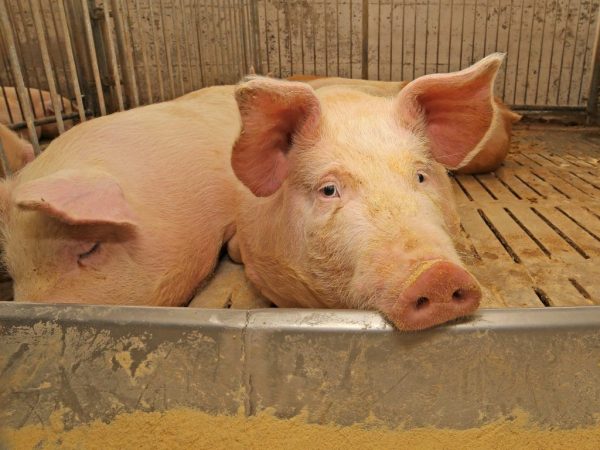Symptoms and treatments for trichinosis in pigs
Porcine trichinosis is a dangerous disease that is especially common among mammals. Domestic pigs, along with wild animals, are susceptible to this zoonosis. A person can also become infected with trichinosis.

Trichinosis of pigs
This disease has been known since ancient times. Written sources retained information that her symptoms were identified in the Carthaginians in 400 BC. e. Researchers believe that the ban on the use of pork meat among Muslims and Jews is associated with the risk of contracting trichinosis. Outbreaks occur periodically in different countries, most often in the United States and Canada. In the post-Soviet space, the disease was diagnosed in Belarus, some regions of Ukraine, certain regions of the Russian Federation, and the Baltic states.
Causative agents of Trichinosis
The disease is caused by Trichinella spiralis helminths, belonging to the Trichinellidae family, the Trichurata suborder. The causative agents are Trichinella of the following types:
- Trichinella spiralis;
- Trichinella pseudospiralis.
Recently, researchers have discovered new types of capsule-free parasites.
These are roundworms of very small sizes: the length of the female is from 3 to 4.5 mm, the male is 1.5 mm, the larvae are only 0.1 mm in height. Trichinella - viviparous helminths. Adults and their offspring penetrate the intestinal wall using a chitinous stylet located at the head end.
The worms that have reached puberty parasitize in the wall of the small intestine, then with the lymph the larvae are carried by the bloodstream throughout the body. In muscle tissue, parasites grow in a spiral. By the end of the first month of life, the larva is overgrown with a capsule, after a year the capsule is covered with lime and in this form it exists for 25 years.
The larvae in lime capsules are very resistant to adverse factors. Weak salting of pig meat and traditional smoking does not cause their death. The larvae die completely when a piece of meat is evenly heated above 70 ° C.
Some sources claim that for the complete destruction of parasites, a long boil is necessary: 1 kilogram of pork must be processed for more than 1.5 hours. With regard to the effect of low temperatures on the causative agents of the disease, the opinions of scientists differed: some consider it possible to disinfect meat at a temperature of -15 ° C for 8 days, others insist on the need to lower the temperature to -25 ... -50 ° C.
Trichinosis symptoms
Pigs can get sick with trichinosis by eating small rodents, raw waste or food debris, and the insides of sick animals. Often the disease goes unnoticed. With a strong infection on days 3-5, the following symptoms are observed:
- heat;
- diarrhea;
- vomiting;
- rapid weight loss;
- muscle pain (pigs lie motionless, limbs extended);
- shallow breathing;
- swelling.
If the animal has not died, the painful state continues for 1–1.5 months until the larvae form capsules. Then the symptoms disappear and the pig looks healthy. The disease becomes chronic.
Diagnosis of Trichinosis
It is very difficult to diagnose the disease during the life of the body, since the larvae are not located in the intestines, but between the fibers of the striated muscles, in the lymphatic or circulatory system, and the symptoms are not always pronounced. The most common methods for recognizing trichinosis are:
- immunological reactions that make it possible to detect antibodies in a living animal by the end of the first month of the disease;
- trichinelloscopy;
- digestion of muscles in artificial gastric juice (carried out posthumously).
To diagnose trichinosis, samples of the legs of the diaphragm are taken near the tendons. Other striated muscles (such as the chewing muscles) can also be used.
When carrying out trichinelloscopy, 24 sections are made from muscle samples, which are crushed in the copressorium, and then examined under a microscope. So you can identify a disease with an average or significant degree of damage to the body by parasites.
The method for digesting muscle tissue in artificial gastric juice is more accurate. For the analysis, take a sample of contaminated meat, grind it and fill it with artificial gastric juice (an aqueous solution containing pepsin and hydrochloric acid). The sample prepared in this way is placed in a thermostat for 4–5 hours, then the liquid is drained, and the sediment is examined under a microscope.
When conducting research, it is necessary to distinguish the larvae of Trichinella from other types of parasites (for example, sarcocysts, young cysticercus).
Treatment and prevention of the disease
Infected animals are not treated. If Trichinella is found in pork, the meat is considered unfit for human consumption. Veterinarians consider insufficient development of treatment for trichinosis. Known drugs that infect intestinal worms and non-encapsulated larvae are albendazole, thiabendazole, mebendazole, parbendazole.
Prevention of the disease consists in conducting thorough studies of meat for the presence of Trichinella. It is forbidden to feed pigs with non-disinfected kitchen waste, carcasses of animals, offal. Pigs should not be allowed to walk freely, especially near woodlands.
Carcasses of animals that show symptoms of the disease or have Trichinella spp. Must be processed into meat and bone meal or burned. It is forbidden to bury the infected meat of dead pigs, as it can become a source of disease for rodents and carnivores. The territories of farms, places of walking are carefully cleaned, and deratization is systematically carried out.
Conclusion
Pork infected with Trichinella is the main source of human infection. An important component of prevention is educational work: explaining the degree of danger of trichinosis, ways of infection, methods of diagnosis and methods of preventing this disease.
Personal prevention rules: only meat that has passed sanitary and veterinary control can be eaten. You can not buy pork on spontaneous markets, the meat must be subjected to prolonged heat treatment.


